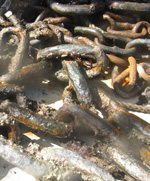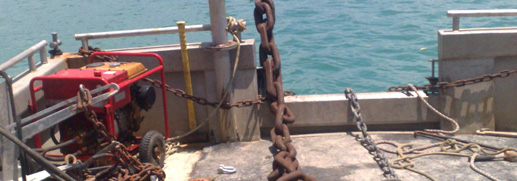


Moorings
The most secure and environmentally friendly mooring grid we can deliver.
Whitsunday Moorings and Marine Construction has been operating in the area for over 6 years. Ken Spruce (Company Director) has lived in the area his entire life, Darren Foster (Company Director) has lived and worked in the local marine industry for sixteen years. Between them they have seen the devastating effects of cyclones Ada and Ului as well as the storm of 2008 and near misses of cyclones Justin and Hamish. During these events they have been studying how and why some moorings failed and others survived. The result is a mooring system that (we think) is equal to the worst a storm can throw at it.
The Whitsundays offers two mooring areas, each with its advantages and disadvantages. Yet, historically there has only been one type of mooring available. The old "Two Tonne Trapezoid Block and Catenary Chain Mooring" has been used as a one size fits all with differing chain lengths, sizes and configurations (i.e. single, double or triple blocks) being the only variations. The result has been the unprecedented carnage that we have observed on our foreshore over the last two years.
Historically, it has been assumed by many Moorings Installers that a two tonne block of concrete with a three or four to one scope would hold a 12 tonne vessel during a storm event. The 2008 disaster proved that this type of mooring could not secure a 6 tonne mono hull let alone a 12 tonne catamaran.
When you start to look into the physics it becomes quite clear; if you have a vessel with a displacement value of 12 tonnes and concrete block that weighs 1.2 tonnes in the water, your vessel is going to have no problems in moving that weight all the way to the shore. The way the trapezoid block is constructed, with the eye on top, means that it is designed to tip over and drag across the bottom. Once it has flipped over, nearly half the weight of the mooring block is levered over its pivot point and is therefore only assisting in the mooring dragging; the effective weight of your mooring is now around 600 kg!
For many years there has been no Australian Standard or Guidelines to ensure the safety of vessels on moorings. However, through many hours of research, speaking to State and Federal Maritime Safety offices as well as International Mooring Installers and Manufacturers, Whitsunday Moorings and Marine Construction Pty Ltd now uses the "Dampier Mooring Code" as a minimum standard and look to exceed that standard with our new rectangular blocks and the "Helix/Seaflex/Block Moorings."
That leaves you with only two questions, which mooring will you trust to leave your vessel on and which mooring will your insurance underwriter accept it being left on?